| diagram |  |
||||||||||||||||||||||||||||||||||||||
| namespace | urn:oasis:names:tc:ciq:xsdschema:xAL:2.0 | ||||||||||||||||||||||||||||||||||||||
| properties |
|
||||||||||||||||||||||||||||||||||||||
| children | AddressLine PremiseName PremiseLocation PremiseNumber PremiseNumberRange PremiseNumberPrefix PremiseNumberSuffix BuildingName SubPremise Firm MailStop PostalCode Premise | ||||||||||||||||||||||||||||||||||||||
| used by |
|
||||||||||||||||||||||||||||||||||||||
| attributes |
|
||||||||||||||||||||||||||||||||||||||
| annotation |
|
||||||||||||||||||||||||||||||||||||||
| source | <element name="Premise"> <annotation> <documentation>Specification of a single premise, for example a house or a building. The premise as a whole has a unique premise (house) number or a premise name. There could be more than one premise in a street referenced in an address. For example a building address near a major shopping centre or raiwlay station</documentation> </annotation> <complexType> <sequence> <element ref="AddressLine" minOccurs="0" maxOccurs="unbounded"/> <element name="PremiseName" minOccurs="0" maxOccurs="unbounded"> <annotation> <documentation>Specification of the name of the premise (house, building, park, farm, etc). A premise name is specified when the premise cannot be addressed using a street name plus premise (house) number.</documentation> </annotation> <complexType mixed="true"> <attribute name="Type"/> <attribute name="TypeOccurrence"> <annotation> <documentation>EGIS Building where EGIS occurs before Building, DES JARDINS occurs after COMPLEXE DES JARDINS</documentation> </annotation> <simpleType> <restriction base="xs:NMTOKEN"> <enumeration value="Before"/> <enumeration value="After"/> </restriction> </simpleType> </attribute> <attributeGroup ref="grPostal"/> <anyAttribute namespace="##other"/> </complexType> </element> <choice minOccurs="0"> <element name="PremiseLocation"> <annotation> <documentation>LOBBY, BASEMENT, GROUND FLOOR, etc...</documentation> </annotation> <complexType mixed="true"> <attributeGroup ref="grPostal"/> <anyAttribute namespace="##other"/> </complexType> </element> <choice> <element ref="PremiseNumber" maxOccurs="unbounded"/> <element name="PremiseNumberRange"> <annotation> <documentation>Specification for defining the premise number range. Some premises have number as Building C1-C7</documentation> </annotation> <complexType> <sequence> <element name="PremiseNumberRangeFrom"> <annotation> <documentation>Start number details of the premise number range</documentation> </annotation> <complexType> <sequence> <element ref="AddressLine" minOccurs="0" maxOccurs="unbounded"/> <element ref="PremiseNumberPrefix" minOccurs="0" maxOccurs="unbounded"/> <element ref="PremiseNumber" maxOccurs="unbounded"/> <element ref="PremiseNumberSuffix" minOccurs="0" maxOccurs="unbounded"/> </sequence> </complexType> </element> <element name="PremiseNumberRangeTo"> <annotation> <documentation>End number details of the premise number range</documentation> </annotation> <complexType> <sequence> <element ref="AddressLine" minOccurs="0" maxOccurs="unbounded"/> <element ref="PremiseNumberPrefix" minOccurs="0" maxOccurs="unbounded"/> <element ref="PremiseNumber" maxOccurs="unbounded"/> <element ref="PremiseNumberSuffix" minOccurs="0" maxOccurs="unbounded"/> </sequence> </complexType> </element> </sequence> <attribute name="RangeType"> <annotation> <documentation>Eg. Odd or even number range</documentation> </annotation> </attribute> <attribute name="Indicator"> <annotation> <documentation>Eg. No. in Building No:C1-C5</documentation> </annotation> </attribute> <attribute name="Separator"> <annotation> <documentation>"-" in 12-14 or "Thru" in 12 Thru 14 etc.</documentation> </annotation> </attribute> <attribute name="Type"/> <attribute name="IndicatorOccurence"> <annotation> <documentation>No.12-14 where "No." is before actual street number</documentation> </annotation> <simpleType> <restriction base="xs:NMTOKEN"> <enumeration value="Before"/> <enumeration value="After"/> </restriction> </simpleType> </attribute> <attribute name="NumberRangeOccurence"> <annotation> <documentation>Building 23-25 where the number occurs after building name</documentation> </annotation> <simpleType> <restriction base="xs:NMTOKEN"> <enumeration value="BeforeName"/> <enumeration value="AfterName"/> <enumeration value="BeforeType"/> <enumeration value="AfterType"/> </restriction> </simpleType> </attribute> </complexType> </element> </choice> </choice> <element ref="PremiseNumberPrefix" minOccurs="0" maxOccurs="unbounded"/> <element ref="PremiseNumberSuffix" minOccurs="0" maxOccurs="unbounded"/> <element name="BuildingName" type="BuildingNameType" minOccurs="0" maxOccurs="unbounded"> <annotation> <documentation>Specification of the name of a building.</documentation> </annotation> </element> <choice> <element name="SubPremise" type="SubPremiseType" minOccurs="0" maxOccurs="unbounded"> <annotation> <documentation>Specification of a single sub-premise. Examples of sub-premises are apartments and suites. Each sub-premise should be uniquely identifiable.</documentation> </annotation> </element> <element name="Firm" type="FirmType" minOccurs="0"> <annotation> <documentation>Specification of a firm, company, organization, etc. It can be specified as part of an address that contains a street or a postbox. It is therefore different from a large mail user address, which contains no street.</documentation> </annotation> </element> </choice> <element name="MailStop" type="MailStopType" minOccurs="0"> <annotation> <documentation>A MailStop is where the the mail is delivered to within a premise/subpremise/firm or a facility.</documentation> </annotation> </element> <element ref="PostalCode" minOccurs="0"/> <element ref="Premise" minOccurs="0"/> <any namespace="##other" minOccurs="0" maxOccurs="unbounded"/> </sequence> <attribute name="Type"> <annotation> <documentation>COMPLEXE in COMPLEX DES JARDINS, A building, station, etc</documentation> </annotation> </attribute> <attribute name="PremiseDependency"> <annotation> <documentation>STREET, PREMISE, SUBPREMISE, PARK, FARM, etc</documentation> </annotation> </attribute> <attribute name="PremiseDependencyType"> <annotation> <documentation>NEAR, ADJACENT TO, etc</documentation> </annotation> </attribute> <attribute name="PremiseThoroughfareConnector"> <annotation> <documentation>DES, DE, LA, LA, DU in RUE DU BOIS. These terms connect a premise/thoroughfare type and premise/thoroughfare name. Terms may appear with names AVE DU BOIS</documentation> </annotation> </attribute> <anyAttribute namespace="##other"/> </complexType> </element> |
attribute Premise/@Type
| annotation |
|
||
| source | <attribute name="Type"> <annotation> <documentation>COMPLEXE in COMPLEX DES JARDINS, A building, station, etc</documentation> </annotation> </attribute> |
attribute Premise/@PremiseDependency
| annotation |
|
||
| source | <attribute name="PremiseDependency"> <annotation> <documentation>STREET, PREMISE, SUBPREMISE, PARK, FARM, etc</documentation> </annotation> </attribute> |
attribute Premise/@PremiseDependencyType
| annotation |
|
||
| source | <attribute name="PremiseDependencyType"> <annotation> <documentation>NEAR, ADJACENT TO, etc</documentation> </annotation> </attribute> |
attribute Premise/@PremiseThoroughfareConnector
| annotation |
|
||
| source | <attribute name="PremiseThoroughfareConnector"> <annotation> <documentation>DES, DE, LA, LA, DU in RUE DU BOIS. These terms connect a premise/thoroughfare type and premise/thoroughfare name. Terms may appear with names AVE DU BOIS</documentation> </annotation> </attribute> |
element Premise/PremiseName
| diagram | 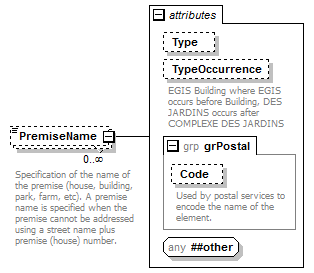 |
||||||||||||||||||||||||||||
| namespace | urn:oasis:names:tc:ciq:xsdschema:xAL:2.0 | ||||||||||||||||||||||||||||
| properties |
|
||||||||||||||||||||||||||||
| attributes |
|
||||||||||||||||||||||||||||
| annotation |
|
||||||||||||||||||||||||||||
| source | <element name="PremiseName" minOccurs="0" maxOccurs="unbounded"> <annotation> <documentation>Specification of the name of the premise (house, building, park, farm, etc). A premise name is specified when the premise cannot be addressed using a street name plus premise (house) number.</documentation> </annotation> <complexType mixed="true"> <attribute name="Type"/> <attribute name="TypeOccurrence"> <annotation> <documentation>EGIS Building where EGIS occurs before Building, DES JARDINS occurs after COMPLEXE DES JARDINS</documentation> </annotation> <simpleType> <restriction base="xs:NMTOKEN"> <enumeration value="Before"/> <enumeration value="After"/> </restriction> </simpleType> </attribute> <attributeGroup ref="grPostal"/> <anyAttribute namespace="##other"/> </complexType> </element> |
attribute Premise/PremiseName/@Type
| source | <attribute name="Type"/> |
attribute Premise/PremiseName/@TypeOccurrence
| type | restriction of NMTOKEN | |||||||||
| facets |
|
|||||||||
| annotation |
|
|||||||||
| source | <attribute name="TypeOccurrence"> <annotation> <documentation>EGIS Building where EGIS occurs before Building, DES JARDINS occurs after COMPLEXE DES JARDINS</documentation> </annotation> <simpleType> <restriction base="xs:NMTOKEN"> <enumeration value="Before"/> <enumeration value="After"/> </restriction> </simpleType> </attribute> |
element Premise/PremiseLocation
| diagram | 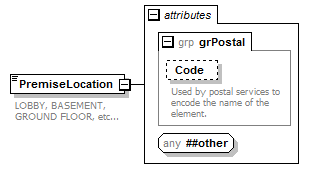 |
||||||||||||||
| namespace | urn:oasis:names:tc:ciq:xsdschema:xAL:2.0 | ||||||||||||||
| properties |
|
||||||||||||||
| attributes |
|
||||||||||||||
| annotation |
|
||||||||||||||
| source | <element name="PremiseLocation"> <annotation> <documentation>LOBBY, BASEMENT, GROUND FLOOR, etc...</documentation> </annotation> <complexType mixed="true"> <attributeGroup ref="grPostal"/> <anyAttribute namespace="##other"/> </complexType> </element> |
element Premise/PremiseNumberRange
| diagram | 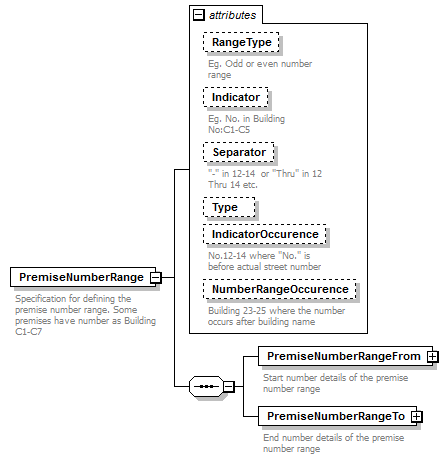 |
||||||||||||||||||||||||||||||||||||||||||||||||||||
| namespace | urn:oasis:names:tc:ciq:xsdschema:xAL:2.0 | ||||||||||||||||||||||||||||||||||||||||||||||||||||
| properties |
|
||||||||||||||||||||||||||||||||||||||||||||||||||||
| children | PremiseNumberRangeFrom PremiseNumberRangeTo | ||||||||||||||||||||||||||||||||||||||||||||||||||||
| attributes |
|
||||||||||||||||||||||||||||||||||||||||||||||||||||
| annotation |
|
||||||||||||||||||||||||||||||||||||||||||||||||||||
| source | <element name="PremiseNumberRange"> <annotation> <documentation>Specification for defining the premise number range. Some premises have number as Building C1-C7</documentation> </annotation> <complexType> <sequence> <element name="PremiseNumberRangeFrom"> <annotation> <documentation>Start number details of the premise number range</documentation> </annotation> <complexType> <sequence> <element ref="AddressLine" minOccurs="0" maxOccurs="unbounded"/> <element ref="PremiseNumberPrefix" minOccurs="0" maxOccurs="unbounded"/> <element ref="PremiseNumber" maxOccurs="unbounded"/> <element ref="PremiseNumberSuffix" minOccurs="0" maxOccurs="unbounded"/> </sequence> </complexType> </element> <element name="PremiseNumberRangeTo"> <annotation> <documentation>End number details of the premise number range</documentation> </annotation> <complexType> <sequence> <element ref="AddressLine" minOccurs="0" maxOccurs="unbounded"/> <element ref="PremiseNumberPrefix" minOccurs="0" maxOccurs="unbounded"/> <element ref="PremiseNumber" maxOccurs="unbounded"/> <element ref="PremiseNumberSuffix" minOccurs="0" maxOccurs="unbounded"/> </sequence> </complexType> </element> </sequence> <attribute name="RangeType"> <annotation> <documentation>Eg. Odd or even number range</documentation> </annotation> </attribute> <attribute name="Indicator"> <annotation> <documentation>Eg. No. in Building No:C1-C5</documentation> </annotation> </attribute> <attribute name="Separator"> <annotation> <documentation>"-" in 12-14 or "Thru" in 12 Thru 14 etc.</documentation> </annotation> </attribute> <attribute name="Type"/> <attribute name="IndicatorOccurence"> <annotation> <documentation>No.12-14 where "No." is before actual street number</documentation> </annotation> <simpleType> <restriction base="xs:NMTOKEN"> <enumeration value="Before"/> <enumeration value="After"/> </restriction> </simpleType> </attribute> <attribute name="NumberRangeOccurence"> <annotation> <documentation>Building 23-25 where the number occurs after building name</documentation> </annotation> <simpleType> <restriction base="xs:NMTOKEN"> <enumeration value="BeforeName"/> <enumeration value="AfterName"/> <enumeration value="BeforeType"/> <enumeration value="AfterType"/> </restriction> </simpleType> </attribute> </complexType> </element> |
attribute Premise/PremiseNumberRange/@RangeType
| annotation |
|
||
| source | <attribute name="RangeType"> <annotation> <documentation>Eg. Odd or even number range</documentation> </annotation> </attribute> |
attribute Premise/PremiseNumberRange/@Indicator
| annotation |
|
||
| source | <attribute name="Indicator"> <annotation> <documentation>Eg. No. in Building No:C1-C5</documentation> </annotation> </attribute> |
attribute Premise/PremiseNumberRange/@Separator
| annotation |
|
||
| source | <attribute name="Separator"> <annotation> <documentation>"-" in 12-14 or "Thru" in 12 Thru 14 etc.</documentation> </annotation> </attribute> |
attribute Premise/PremiseNumberRange/@Type
| source | <attribute name="Type"/> |
attribute Premise/PremiseNumberRange/@IndicatorOccurence
| type | restriction of NMTOKEN | |||||||||
| facets |
|
|||||||||
| annotation |
|
|||||||||
| source | <attribute name="IndicatorOccurence"> <annotation> <documentation>No.12-14 where "No." is before actual street number</documentation> </annotation> <simpleType> <restriction base="xs:NMTOKEN"> <enumeration value="Before"/> <enumeration value="After"/> </restriction> </simpleType> </attribute> |
attribute Premise/PremiseNumberRange/@NumberRangeOccurence
| type | restriction of NMTOKEN | |||||||||||||||
| facets |
|
|||||||||||||||
| annotation |
|
|||||||||||||||
| source | <attribute name="NumberRangeOccurence"> <annotation> <documentation>Building 23-25 where the number occurs after building name</documentation> </annotation> <simpleType> <restriction base="xs:NMTOKEN"> <enumeration value="BeforeName"/> <enumeration value="AfterName"/> <enumeration value="BeforeType"/> <enumeration value="AfterType"/> </restriction> </simpleType> </attribute> |
element Premise/PremiseNumberRange/PremiseNumberRangeFrom
| diagram | 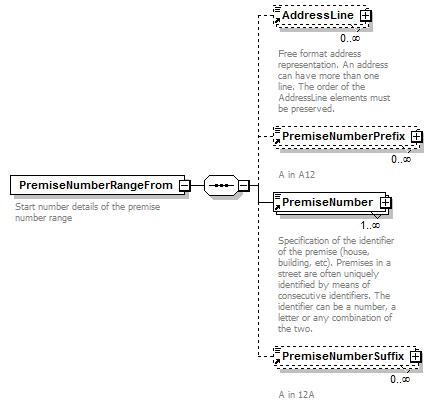 |
||
| namespace | urn:oasis:names:tc:ciq:xsdschema:xAL:2.0 | ||
| properties |
|
||
| children | AddressLine PremiseNumberPrefix PremiseNumber PremiseNumberSuffix | ||
| annotation |
|
||
| source | <element name="PremiseNumberRangeFrom"> <annotation> <documentation>Start number details of the premise number range</documentation> </annotation> <complexType> <sequence> <element ref="AddressLine" minOccurs="0" maxOccurs="unbounded"/> <element ref="PremiseNumberPrefix" minOccurs="0" maxOccurs="unbounded"/> <element ref="PremiseNumber" maxOccurs="unbounded"/> <element ref="PremiseNumberSuffix" minOccurs="0" maxOccurs="unbounded"/> </sequence> </complexType> </element> |
element Premise/PremiseNumberRange/PremiseNumberRangeTo
| diagram | 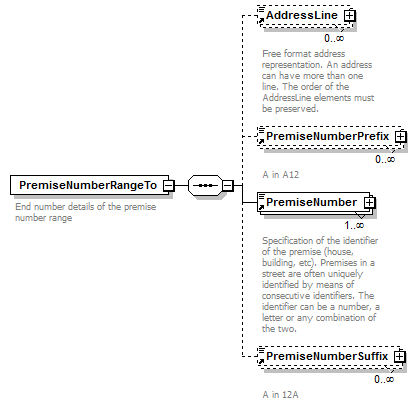 |
||
| namespace | urn:oasis:names:tc:ciq:xsdschema:xAL:2.0 | ||
| properties |
|
||
| children | AddressLine PremiseNumberPrefix PremiseNumber PremiseNumberSuffix | ||
| annotation |
|
||
| source | <element name="PremiseNumberRangeTo"> <annotation> <documentation>End number details of the premise number range</documentation> </annotation> <complexType> <sequence> <element ref="AddressLine" minOccurs="0" maxOccurs="unbounded"/> <element ref="PremiseNumberPrefix" minOccurs="0" maxOccurs="unbounded"/> <element ref="PremiseNumber" maxOccurs="unbounded"/> <element ref="PremiseNumberSuffix" minOccurs="0" maxOccurs="unbounded"/> </sequence> </complexType> </element> |
element Premise/BuildingName
| diagram | 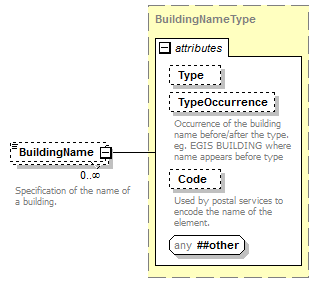 |
||||||||||||||||||||||||||||
| namespace | urn:oasis:names:tc:ciq:xsdschema:xAL:2.0 | ||||||||||||||||||||||||||||
| type | BuildingNameType | ||||||||||||||||||||||||||||
| properties |
|
||||||||||||||||||||||||||||
| attributes |
|
||||||||||||||||||||||||||||
| annotation |
|
||||||||||||||||||||||||||||
| source | <element name="BuildingName" type="BuildingNameType" minOccurs="0" maxOccurs="unbounded"> <annotation> <documentation>Specification of the name of a building.</documentation> </annotation> </element> |
element Premise/SubPremise
| diagram | 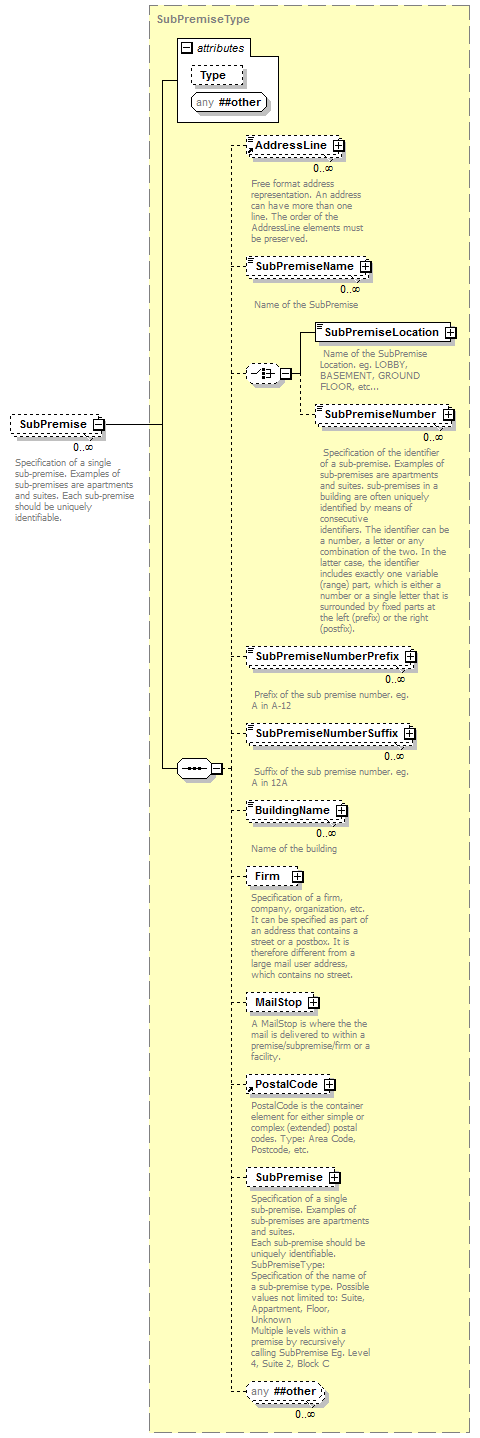 |
||||||||||||
| namespace | urn:oasis:names:tc:ciq:xsdschema:xAL:2.0 | ||||||||||||
| type | SubPremiseType | ||||||||||||
| properties |
|
||||||||||||
| children | AddressLine SubPremiseName SubPremiseLocation SubPremiseNumber SubPremiseNumberPrefix SubPremiseNumberSuffix BuildingName Firm MailStop PostalCode SubPremise | ||||||||||||
| attributes |
|
||||||||||||
| annotation |
|
||||||||||||
| source | <element name="SubPremise" type="SubPremiseType" minOccurs="0" maxOccurs="unbounded"> <annotation> <documentation>Specification of a single sub-premise. Examples of sub-premises are apartments and suites. Each sub-premise should be uniquely identifiable.</documentation> </annotation> </element> |
element Premise/Firm
| diagram | 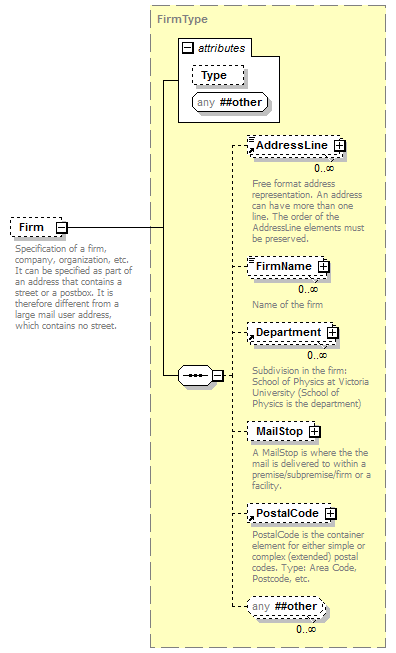 |
||||||||||||
| namespace | urn:oasis:names:tc:ciq:xsdschema:xAL:2.0 | ||||||||||||
| type | FirmType | ||||||||||||
| properties |
|
||||||||||||
| children | AddressLine FirmName Department MailStop PostalCode | ||||||||||||
| attributes |
|
||||||||||||
| annotation |
|
||||||||||||
| source | <element name="Firm" type="FirmType" minOccurs="0"> <annotation> <documentation>Specification of a firm, company, organization, etc. It can be specified as part of an address that contains a street or a postbox. It is therefore different from a large mail user address, which contains no street.</documentation> </annotation> </element> |
element Premise/MailStop
| diagram | 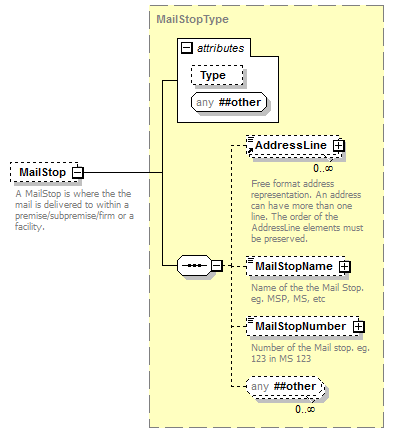 |
||||||||||||
| namespace | urn:oasis:names:tc:ciq:xsdschema:xAL:2.0 | ||||||||||||
| type | MailStopType | ||||||||||||
| properties |
|
||||||||||||
| children | AddressLine MailStopName MailStopNumber | ||||||||||||
| attributes |
|
||||||||||||
| annotation |
|
||||||||||||
| source | <element name="MailStop" type="MailStopType" minOccurs="0"> <annotation> <documentation>A MailStop is where the the mail is delivered to within a premise/subpremise/firm or a facility.</documentation> </annotation> </element> |
XML Schema documentation generated by XMLSpy Schema Editor http://www.altova.com/xmlspy